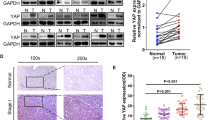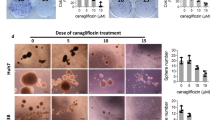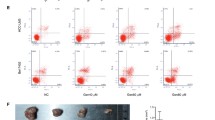Abstract
Hepatocellular carcinoma (HCC) is commonly associated with disturbances in glucose metabolism and enhanced glycolysis. However, a controversial role for gluconeogenesis was reported to be tumor-promoting and tumor-suppressive. We investigated novel anti-HCC treatments through either the simultaneous inhibition of glycolysis and gluconeogenesis by “phloretin” and “sodium meta-arsenite”, respectively (Combination 1); or the concurrent inhibition of glycolysis and induction of gluconeogenesis by phloretin and dexamethasone, respectively, (combination 2). A total of 110 Swiss albino mice were divided into eleven groups, HCC was induced by N, N-dimethyl-4-aminoazobenzene. We have measured the expression of the glucose transporter 2 (GLUT2), Phosphoenolpyruvate carboxykinases (PEPCK), Caspase-3, Beclin 1, Cyclin D1, and cytokeratin 18 genes; blood glucose and ATP levels; alanine aminotransferase (ALT) and aspartate aminotransferase (AST) activities. Furthermore, in silico molecular docking was performed to investigate the potential drug-receptor interactions. Histologically, the phloretin-based combinations resulted in a significant regression of malignant tissue compared to various treatments. GLUT2 and PEPCK mRNA analysis indicated successful off/on modulation of glycolysis and gluconeogenesis. Docking confirmed the potent binding between phloretin, sodium meta-arsenite, and dexamethasone with GLUT2, PEPCK, and Retinoid X Receptor Alpha, respectively. Molecularly, Combination 2 resulted in the highest reduction in cyclin D1, cytokeratin 18, and Beclin 1 expression contemporaneously with the upregulation in Caspase-3 levels. Biochemically, both combinations caused a significant reduction in ATP levels, ALT, and AST activity compared to the other groups. In conclusion, we propose two novel phloretin-based combinations that can be used in treating HCC through the regulation of glucose metabolism and ATP production.











Similar content being viewed by others
Availability of supporting data
The data presented in this study are available on request from the corresponding author.
References
Ge Y, Zhao R, Li B, et al. Aerobic glycolysis and tumor progression of hepatocellular carcinoma are mediated by ubiquitin of P53 K48-linked regulated by TRIM37. Exp Cell Res. 2022;421: 113377.
Cramer T. Impact of dietary carbohydrate restriction on the pathobiology of hepatocellular carcinoma: the gut-liver axis and beyond. Semin Immunol. 2023;101736.
Tilekar K, Upadhyay N, Iancu CV et al. Power of two: combination of therapeutic approaches involving glucose transporter (GLUT) inhibitors to combat cancer. Biochim Biophys Acta (BBA) Rev Cancer. 2020;1874:188457
Feng J, Li J, Wu L, et al. Emerging roles and the regulation of aerobic glycolysis in hepatocellular carcinoma. J Exp Clin Cancer Res. 2020;39:1–19.
Xia H, Chen J, Gao H, et al. Hypoxia-induced modulation of glucose transporter expression impacts 18 F-fluorodeoxyglucose PET-CT imaging in hepatocellular carcinoma. Eur J Nucl Med Mol Imaging. 2020;47:787–97.
Abbaszadeh Z, Çeşmeli S, Avcı ÇB. Crucial players in glycolysis: cancer progress. Gene. 2020;726: 144158.
Liang B, Jiang Y, Song S, et al. ASPP2 suppresses tumour growth and stemness characteristics in HCC by inhibiting Warburg effect via WNT/β-catenin/HK2 axis. J Cell Mol Med. 2023;27:659–71.
Cossu V, Bonanomi M, Bauckneht M, et al. Two high-rate pentose-phosphate pathways in cancer cells. Sci Rep. 2020;10:22111.
Mukherjee S, Bhatti GK, Chhabra R, et al. Targeting mitochondria as a potential therapeutic strategy against chemoresistance in cancer. Biomed Pharmacother. 2023;160: 114398.
Zaidi S, Gandhi J, Joshi G, et al. The anticancer potential of metformin on prostate cancer. Prostate Cancer Prostatic Dis. 2019;22:351–61.
Wu W, Dang S, Feng Q, et al. MicroRNA-542-3p inhibits the growth of hepatocellular carcinoma cells by targeting FZD7/Wnt signaling pathway. Biochem Biophys Res Commun. 2017;482:100–5.
Chadt A, Al-Hasani H. Glucose transporters in adipose tissue, liver, and skeletal muscle in metabolic health and disease. Pflügers Arch J Physiol. 2020;472:1273–98.
Choi BY. Biochemical basis of anti-cancer-effects of phloretin—a natural dihydrochalcone. Molecules. 2019;24:278.
Shiratori R, Furuichi K, Yamaguchi M, et al. Glycolytic suppression dramatically changes the intracellular metabolic profile of multiple cancer cell lines in a mitochondrial metabolism-dependent manner. Sci Rep. 2019;9:1–15.
Grasmann G, Smolle E, Olschewski H, Leithner K. Gluconeogenesis in cancer cells–repurposing of a starvation-induced metabolic pathway? Biochim Biophys Acta (BBA)-Rev Cancer. 2019;1872:24–36
Montal ED, Dewi R, Bhalla K, et al. PEPCK coordinates the regulation of central carbon metabolism to promote cancer cell growth. Mol Cell. 2015;60:571–83.
Lee Y-S, Lee E-K, Oh H-H et al. Sodium meta-arsenite ameliorates hyperglycemia in obese diabetic db/db mice by inhibition of hepatic gluconeogenesis. J Diabetes Res. 2014.
Wang XL, Herzog B, Waltner-Law M, et al. The synergistic effect of dexamethasone and all-trans-retinoic acid on hepatic phosphoenolpyruvate carboxykinase gene expression involves the coactivator p300. J Biol Chem. 2004;279:34191–200.
Pathak S, Kumar Das J, Jyoti Biswas S, Khuda-Bukhsh AR. Protective potentials of a potentized homeopathic drug, Lycopodium-30, in ameliorating azo dye induced hepatocarcinogenesis in mice. Mol Cell Biochem. 2006;285:121–31.
Mariadoss AVA, Vinyagam R, Rajamanickam V, et al. Pharmacological aspects and potential use of phloretin: a systemic review. Mini Rev Med Chem. 2019;19:1060–7.
Shang F, Liu M, Li B, et al. The anti-angiogenic effect of dexamethasone in a murine hepatocellular carcinoma model by augmentation of gluconeogenesis pathway in malignant cells. Cancer Chemother Pharmacol. 2016;77:1087–96.
Elmetwalli A, Hashish SM, Hassan MG et al. Modulation of the oxidative damage, inflammation, and apoptosis-related genes by dicinnamoyl-L-tartaric acid in liver cancer. Naunyn Schmiedebergs Arch Pharmacol. 2023b;1–13.
Elmetwalli A, Diab T, Albalawi AN et al. Diarylheptanoids/sorafenib as a potential anticancer combination against hepatocellular carcinoma: the p53/MMP9 axis of action. Naunyn Schmiedebergs Arch Pharmacol. 2023a;1–17.
Attia AA, Salama AF, Eldiasty JG, et al. Amygdalin potentiates the anti-cancer effect of Sorafenib on Ehrlich ascites carcinoma and ameliorates the associated liver damage. Sci Rep. 2022;12:1–9.
Bancroft JD, Layton C. The hematoxylins and eosin. Bancroft’s Theory Pract Histol Tech. 2012;7:173–86.
El-Shehawy AA, Elmetwalli A, El-Far AH, et al. Thymoquinone, piperine, and sorafenib combinations attenuate liver and breast cancers progression: epigenetic and molecular docking approaches. BMC Complement Med Ther. 2023;23:1–21.
Nasser HM, El-Naggar SA, El-Sayed Rizk ME-SR, et al. Effect of sorafenib on liver biochemistry prior to vitamin B17 coadministration in ehrlich ascites carcinoma mice model: preliminary phase study. Biochem Lett. 2021;17:40–9.
Liu D, Song T. Changes in and challenges regarding the surgical treatment of hepatocellular carcinoma in China. Biosci Trends. 2021;15:142–7.
He Z, Chen Q, He W, et al. Hepatocellular carcinoma subtypes based on metabolic pathways reveals potential therapeutic targets. Front Oncol. 2023;13:1086604.
Bian X, Chen H, Yang P, et al. Nur77 suppresses hepatocellular carcinoma via switching glucose metabolism toward gluconeogenesis through attenuating phosphoenolpyruvate carboxykinase sumoylation. Nat Commun. 2017;8:14420.
Tian H, Zhu X, Lv Y, et al. Glucometabolic reprogramming in the hepatocellular carcinoma microenvironment: cause and effect. Cancer Manag Res. 2020;12:5957.
Wang Z, Dong C. Gluconeogenesis in cancer: function and regulation of PEPCK, FBPase, and G6Pase. Trends Cancer. 2019;5:30–45.
Biswas SJ, Gorain S, Patra M et al. Evaluating the chemopreventive properties of aqueous seed extract of trigonella foenum graecum against p-dimethylaminoazobenzene (p-DAB) induced carcinogenesis in mice. Fenugreek. 2021;6:481–502.
Un H, Ugan RA, Gurbuz MA, et al. Phloretin and phloridzin guard against cisplatin-induced nephrotoxicity in mice through inhibiting oxidative stress and inflammation. Life Sci. 2021;266: 118869.
Klueh U, Liu Z, Cho B, et al. Continuous glucose monitoring in normal mice and mice with prediabetes and diabetes. Diabetes Technol Ther. 2006;8:402–12.
Bai Q, Liu Y, Wang C-M et al. Hepatic but not intestinal FBP1 is required for fructose metabolism and tolerance. Endocrinology. 2023;164:bqad054.
Wu S, Zhang K, Liang Y, et al. Nano-enabled tumor Systematic energy exhaustion via zinc (II) interference mediated glycolysis inhibition and specific GLUT1 depletion. Adv Sci. 2022;9:2103534.
Saraei P, Asadi I, Kakar MA, Moradi-Kor N. The beneficial effects of metformin on cancer prevention and therapy: a comprehensive review of recent advances. Cancer Manag Res. 2019;11:3295.
Sheng H, Niu B, Sun H. Metabolic targeting of cancers: from molecular mechanisms to therapeutic strategies. Curr Med Chem. 2009;16:1561–87.
George Thompson AM, Ursu O, Babkin P, et al. Discovery of a specific inhibitor of human GLUT5 by virtual screening and in vitro transport evaluation. Sci Rep. 2016;6:1–9.
Leone RD, Powell JD. Metabolism of immune cells in cancer. Nat Rev Cancer. 2020;20:516–31.
Vander Heiden MG, Cantley LC, Thompson CB. Understanding the Warburg effect: the metabolic requirements of cell proliferation. Science (80-). 2009;324:1029–33.
Park D-B. Metformin promotes apoptosis but suppresses autophagy in glucose-deprived H4IIE hepatocellular carcinoma cells. Diabetes Metab J. 2015;39:518–27.
Wei R, Mao L, Xu P, et al. Suppressing glucose metabolism with epigallocatechin-3-gallate (EGCG) reduces breast cancer cell growth in preclinical models. Food Funct. 2018;9:5682–96.
Li H, Li X, Liu S, et al. Programmed cell death-1 (PD-1) checkpoint blockade in combination with a mammalian target of rapamycin inhibitor restrains hepatocellular carcinoma growth induced by hepatoma cell–intrinsic PD-1. Hepatology. 2017;66:1920–33.
Kang K, Wang X, Chen X, et al. Beclin 1 and nuclear factor-κBp65 are upregulated in hepatocellular carcinoma. Oncol Lett. 2013;5:1813–8.
Pierotti MA, Berrino F, Gariboldi M, et al. Targeting metabolism for cancer treatment and prevention: metformin, an old drug with multi-faceted effects. Oncogene. 2013;32:1475–87.
Nardone V, Barbarino M, Angrisani A, et al. CDK4, CDK6/cyclin-D1 complex inhibition and radiotherapy for cancer control: a role for autophagy. Int J Mol Sci. 2021;22:8391.
Costa RH, Kalinichenko VV, Holterman A-XL, Wang X. Transcription factors in liver development, differentiation, and regeneration. Hepatology. 2003;38:1331–47.
Karra AG, Tziortziou M, Kylindri P, et al. Boswellic acids and their derivatives as potent regulators of glucocorticoid receptor actions. Arch Biochem Biophys. 2020;695: 108656.
De Bosscher K, Vanden Berghe W, Haegeman G. The interplay between the glucocorticoid receptor and nuclear factor-κB or activator protein-1: molecular mechanisms for gene repression. Endocr Rev. 2003;24:488–522.
Sarkar D, Dutta D, Mandal SC, Bose S. Role of tea polyphenols in diabetes. Pharma Rev Sept. 2018;109–117.
Lin S-C, Chen M-C, Liu S, et al. Phloretin inhibits Zika virus infection by interfering with cellular glucose utilisation. Int J Antimicrob Agents. 2019;54:80–4.
Lai Y, Huang H, Abudoureyimu M, et al. Non-coding RNAs: emerging regulators of glucose metabolism in hepatocellular carcinoma. Am J Cancer Res. 2020;10:4066.
Moreno-Sánchez R, Rodríguez-Enríquez S, Marín-Hernández A, Saavedra E. Energy metabolism in tumor cells. FEBS J. 2007;274:1393–418.
Wu C, Ho Y, Tsai C, et al. In vitro and in vivo study of phloretin-induced apoptosis in human liver cancer cells involving inhibition of type II glucose transporter. Int J cancer. 2009;124:2210–9.
Tang Y, Zhang Y, Wang C, et al. Overexpression of PCK1 gene antagonizes hepatocellular carcinoma through the activation of gluconeogenesis and suppression of glycolysis pathways. Cell Physiol Biochem. 2018;47:344–55.
de Oliveira MR. Phloretin-induced cytoprotective effects on mammalian cells: a mechanistic view and future directions. BioFactors. 2016;42:13–40.
Shang A, Liu H-Y, Luo M, et al. Sweet tea (Lithocarpus polystachyus rehd.) as a new natural source of bioactive dihydrochalcones with multiple health benefits. Crit Rev Food Sci Nutr. 2022;62:917–34.
Acknowledgements
NA.
Funding
NA.
Author information
Authors and Affiliations
Contributions
Conceptualization, N.H.K, A.I.Y., A.E., T.E.S.,; Formal analysis, M.M.S, K.M.A.E; Investigation, N.H.K, A.I.Y.,; Project administration, A.I.Y., A.E., T.E.S.,; Software, N.H.K, A.I.Y.; Validation A.I.Y., A.E., T.E.S.; Visualization, A.I.Y., A.E., T.E.S.; Writing—original draft, A.E.; Writing—review and editing, A.E, T.E.S; all authors have read and agreed to the published version of the manuscript. The authors declare that all data were generated in-house and that no paper mill was used.
Corresponding author
Ethics declarations
Conflict of interest
The authors declare no competing interests.
Ethical approval and consent to participate
The study was conducted according to the guidelines of ARRIVE and approved by the Ethical Committee at the Medical Research Institute, Alexandria University.
Consent for publication
NA.
Additional information
Publisher's Note
Springer Nature remains neutral with regard to jurisdictional claims in published maps and institutional affiliations.
Rights and permissions
Springer Nature or its licensor (e.g. a society or other partner) holds exclusive rights to this article under a publishing agreement with the author(s) or other rightsholder(s); author self-archiving of the accepted manuscript version of this article is solely governed by the terms of such publishing agreement and applicable law.
About this article
Cite this article
Elmetwalli, A., Kamosh, N.H., El Safty, R. et al. Novel phloretin-based combinations targeting glucose metabolism in hepatocellular carcinoma through GLUT2/PEPCK axis of action: in silico molecular modelling and in vivo studies. Med Oncol 41, 12 (2024). https://doi.org/10.1007/s12032-023-02236-x
Received:
Accepted:
Published:
DOI: https://doi.org/10.1007/s12032-023-02236-x




